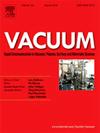通过分子动力学模拟和实验研究 304 不锈钢的纳米组织行为和结构演化
IF 3.8
2区 材料科学
Q2 MATERIALS SCIENCE, MULTIDISCIPLINARY
引用次数: 0
摘要
304 不锈钢具有优异的机械性能,常用于超精密仪器。然而,对 304 不锈钢在超精密加工过程中复杂的纳米摩擦学行为的研究仍然有限。本文通过分子动力学(MD)模拟和纳米划痕测试,研究了 304 不锈钢在不同压痕深度和划痕速度下的摩擦学行为。结果表明,压痕深度越大,304 不锈钢表面和亚表面的损伤越严重。摩擦力和摩擦系数也随着压痕深度的增加而显著增大。值得注意的是,低压痕深度处的位错密度要小得多,这是由于该深度处存在大规模位错湮灭。随着划痕速度的增加,表层下的剪应力减小,位错长度增加,并伴随着 V 形位错的产生,这是由基材内部的位错纠缠引起的。此外,还进行了纳米划痕测试,通过将结果与模拟结果进行比较,也得出了类似的趋势。这项研究为深入理解 304 不锈钢在纳米划痕过程中的变形行为及其在微米和纳米尺度上的工程应用提供了理论指导。本文章由计算机程序翻译,如有差异,请以英文原文为准。
Nano-tribological behavior and structural evolution of 304 stainless-steel by molecular dynamics simulation and experiment
304 stainless-steel has excellent mechanical properties and is commonly used in ultra-precision instrumentation. Nevertheless, the research on the intricate nano tribological behavior of 304 stainless-steel during ultra-precision machining remains limited. In this work, the tribological behavior of 304 stainless-steel is investigated at different indentation depths and scratching velocities by molecular dynamics (MD) simulations and nano-scratch tests. The results show that higher indentation depths lead to more serious damage on the surface and subsurface of 304 stainless-steel. The friction force and friction coefficient also increase significantly with higher indentation depths. It is worth noting that the dislocation density is much smaller at the low-indentation depth, which is due to the large-scale dislocation annihilation at this depth. As the scratch velocity increases, the subsurface shear stress decreases, the dislocation length rises, and it is accompanied by the generation of V-shaped dislocations, which are caused by dislocation entanglement within the substrate. In addition, nano-scratch tests were performed and similar trends were obtained by comparing the results with simulations. This work provides theoretical guidance for a deeper understanding of the deformation behavior of 304 stainless-steel during nano-scratching and its engineering applications at the micron and nano-meter scales.
求助全文
通过发布文献求助,成功后即可免费获取论文全文。
去求助
来源期刊

Vacuum
工程技术-材料科学:综合
CiteScore
6.80
自引率
17.50%
发文量
0
审稿时长
34 days
期刊介绍:
Vacuum is an international rapid publications journal with a focus on short communication. All papers are peer-reviewed, with the review process for short communication geared towards very fast turnaround times. The journal also published full research papers, thematic issues and selected papers from leading conferences.
A report in Vacuum should represent a major advance in an area that involves a controlled environment at pressures of one atmosphere or below.
The scope of the journal includes:
1. Vacuum; original developments in vacuum pumping and instrumentation, vacuum measurement, vacuum gas dynamics, gas-surface interactions, surface treatment for UHV applications and low outgassing, vacuum melting, sintering, and vacuum metrology. Technology and solutions for large-scale facilities (e.g., particle accelerators and fusion devices). New instrumentation ( e.g., detectors and electron microscopes).
2. Plasma science; advances in PVD, CVD, plasma-assisted CVD, ion sources, deposition processes and analysis.
3. Surface science; surface engineering, surface chemistry, surface analysis, crystal growth, ion-surface interactions and etching, nanometer-scale processing, surface modification.
4. Materials science; novel functional or structural materials. Metals, ceramics, and polymers. Experiments, simulations, and modelling for understanding structure-property relationships. Thin films and coatings. Nanostructures and ion implantation.
 求助内容:
求助内容: 应助结果提醒方式:
应助结果提醒方式:


